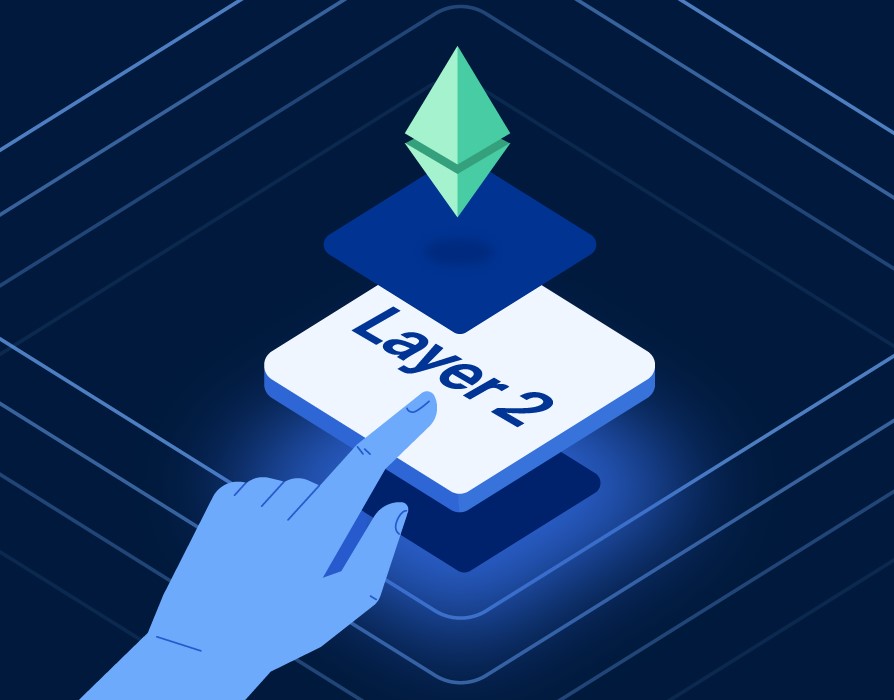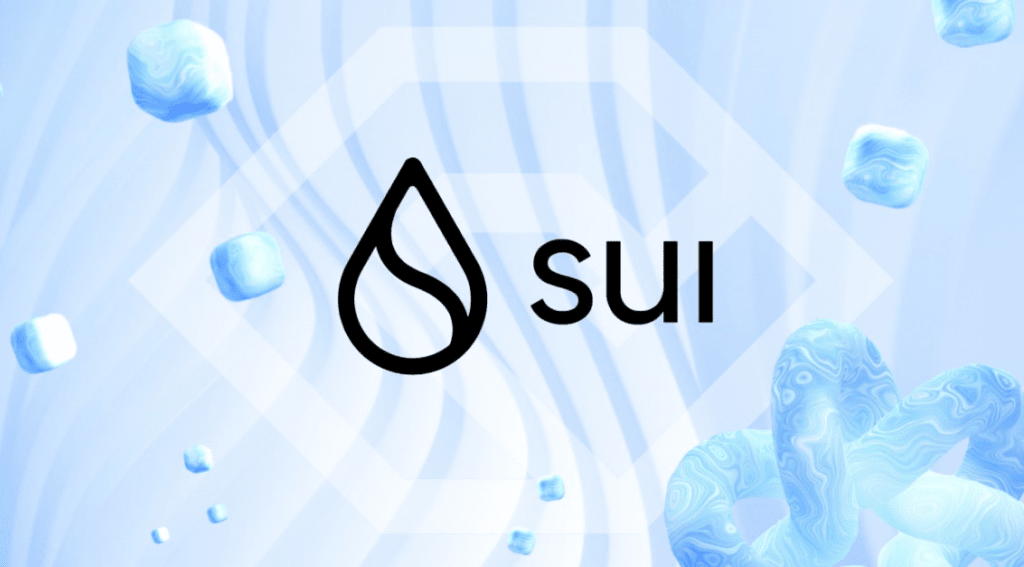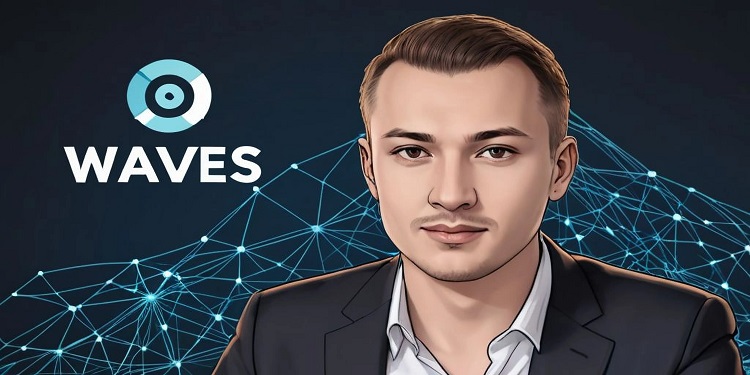Layer-2 networks are critical to the future of blockchain technology, especially as demand for decentralized apps and services increases.
By 2025, Layer-2 networks will be dominant in Ethereum’s ecosystem. They will empower decentralized apps (dApps), enable smooth DeFi interactions, and boost Ethereum’s scalability, transforming the blockchain ecosystem.
As these networks gain traction, they will become critical to the future of decentralized technology. Let’s look at what layer-2 networks are.
What Are Layer-2 Networks?
Layer-2 networks are off-chain solutions that run on the foundation of a Layer-1 blockchain, such as Ethereum. They aim to increase transaction throughput, lower gas fees, and improve the overall user experience.
By offloading certain transaction processing from the main blockchain (Layer-1), these networks allow for faster and more cost-effective interactions.
The Benefits of Layer-2 Networks
Ethereum’s rising popularity has highlighted various limitations of its Layer-1 network, most notably scalability and expensive gas fees. As more decentralized apps (dApps), DeFi protocols, and NFT platforms use Ethereum, the network gets congested.
This congestion causes poor transaction speeds and exorbitant prices, particularly during times of high demand.
Layer-2 networks offer scalability:
Layer-2 networks greatly improve Ethereum’s scalability by processing more transactions per second (TPS) than the main Layer-1 chain. Ethereum’s current capacity is roughly 30 TPS, which causes congestion during peak activity.
Layer-2 networks such as rollups and sidechains increase this capacity to thousands of TPS, allowing Ethereum to meet the growing demand from dApps, DeFi protocols, and non-fungible token (NFT) platforms.
Transferring transaction processing to layer 2 reduces congestion on the main chain, resulting in faster transaction speeds and a smoother experience for users.
Cost-Effectiveness:
Layer-2 networks can significantly lower gas fees, making them highly cost-effective. Because most transaction processing takes place off-chain, the need for block space on Ethereum’s Layer-1 is reduced, resulting in less competition and lower costs.
For users interacting with dApps, particularly in high-traffic DeFi environments, this makes activities such as trading, staking, and NFT minting significantly less expensive. With Layer-2 networks, even microtransactions become possible, paving the way for higher adoption and accessibility.
Security:
Layer-2 networks ensure Ethereum’s main chain remains secure, even while processing transactions off-chain. This is critical for maintaining decentralization and ensuring that transactions and data are secure.
Layer-2 networks, such as optimistic rollups and ZK-rollups, send aggregated transaction data back to Layer-1, where it can be verified and validated as needed. This implies that, despite interacting on Layer-2, users benefit from the strong security and decentralization provided by Ethereum’s Layer-1 blockchain, which provides a trustworthy environment for transaction processing.
User Experience:
Layer-2 networks significantly improve the user experience on Ethereum. Users connect with DeFi platforms, NFT markets, and other dApps quickly and smoothly as transaction times and gas fees are reduced.
This is especially important because Ethereum wants to preserve its position as the top smart contract platform in the blockchain world.
Whether users are minting NFTs, engaging in DeFi yield farming, or simply transferring assets, Layer-2 networks make the Ethereum ecosystem more accessible and affordable, resulting in increased user adoption and retention.
Layer-2 networks significantly increase Ethereum’s speed, making it more scalable, inexpensive, secure, and user-friendly, all of which will drive the blockchain’s progress by 2025.
How Do Layer 2 Networks Work?
Layer-2 networks are off-chain scaling solutions that operate on top of Ethereum’s Layer-1 to improve its efficiency, particularly in terms of transaction speed and cost. Here’s how they operate:
Rollups: Rollups are a popular Layer-2 solution, available in two forms: optimistic rollups and Zero-Knowledge Rollups (ZK-Rollups).
- Optimistic Rollups: These assume transactions are authentic by default, but anyone can dispute a fraudulent transaction within a certain time range. If a challenge arises, the transaction is verified by executing it on the Layer-1 chain (Ethereum).
This approach enables processing a huge number of transactions off-chain while ensuring the security of Ethereum’s main chain.
- ZK-Rollups (or Zero-Knowledge Rollups): ZK-Rollups combine hundreds of transactions off-chain to build a cryptographic proof (known as a ZK-SNARK) that is put on Ethereum’s Layer-1.
This proof confirms that all transactions in the rollup are correct without revealing any transaction specifics. ZK-Rollups offer stronger security and speedier finality than Optimistic Rollups, but they are more difficult to implement.
Sidechains: A sidechain is a distinct blockchain that runs alongside Ethereum. Sidechains run independently but are linked to Ethereum via a bridge, allowing users to transfer assets between the two.
Unlike rollups, sidechains do not directly inherit the security of Ethereum’s Layer-1, but they can still provide faster transaction speeds and reduced fees. Sidechains include Polygon (Matic) and xDai.
State Channels: Off-chain interaction between users is enabled through state channels. A multi-signature contract is constructed on Ethereum’s main chain, allowing users to send several transactions off-chain without needing Layer-1 verification for each one.
Only once the interaction is completed is the final transaction sent to Ethereum for validation. This is extremely efficient for applications that involve frequent transactions, such as gaming or micropayments, because it eliminates the need for constant Layer-1 interaction.
Plasma: Plasma chains are a type of Layer-2 scaling that creates a mini blockchain that runs off Ethereum’s main chain. Plasma chains package transactions and regularly send them to Ethereum’s Layer-1 for validation.
Plasma, like rollups, has more limited functionality and is mostly used for token transfers rather than complicated smart contracts.
How Layer-2 Networks Improve Ethereum
- Transaction Efficiency: By shifting the majority of transaction processing off-chain, Layer-2 networks allow Ethereum to handle much more transactions per second (TPS) than Layer-1.
- Reduced Gas Fees: Because most transactions take place off-chain, there is less competition for block space on Ethereum, resulting in cheaper gas fees for users.
- Retained Security: Rollups and sidechains maintain Ethereum’s robust Layer-1 security by periodically uploading transaction data to the main chain for validation, guaranteeing that off-chain transactions are decentralized and secure.
These technologies make Ethereum more scalable and cost-effective, establishing Layer-2 networks as a key breakthrough in the blockchain ecosystem by 2025.
Why Layer-2 Networks Will Dominate Ethereum by 2025
As Ethereum faces increased demand for scalability, cost-efficiency, and speed, Layer-2 networks are emerging as the most viable answer to the Ethereum main chain’s inherent restrictions.
These Layer-2 networks are built to improve Ethereum’s performance while maintaining its security and decentralization. Here’s a detailed look at why Layer-2 networks are expected to dominate Ethereum by 2025:
- Scalability Without compromising security
- Cost-effectiveness: Reducing Gas Fees
- Streamless User Experience and Developer Adoption
- Synergy with Ethereum 2.0
- Expanding Layer-2 Ecosystem
Scalability Without Compromising Security
Ethereum has been at the vanguard of decentralized apps (dApps), but its rising popularity has shown the limitations of its Layer-1 structure, particularly its limited throughput and high transaction costs.
Layer-2 networks address these difficulties by taking a major amount of transactions off-chain while still depending on Ethereum’s security for validation.
Optimistic Rollups and zk-Rollups are examples of Layer-2 scaling solutions that can execute thousands of transactions per second (TPS), as opposed to Ethereum’s average of roughly 15 TPS on Layer 1.
Rollups combine many transactions and send the compressed data to the Ethereum main chain, greatly improving throughput while maintaining Layer-1 security.
Other Layer-2 options for scalability include sidechains and state channels, which allow for off-chain interactions and reduce the workload on Ethereum’s base layer.
By 2025, as Ethereum grows in transaction volume from decentralized finance (DeFi) and non-fungible tokens (NFTs), these Layer-2 solutions will be critical in ensuring scalability without jeopardizing the network’s primary values of decentralization and security.
Cost-effectiveness: Reducing Gas Fees
Users and developers have long complained about Ethereum’s high gas prices, which make it expensive to interact with decentralized apps (dApps), execute smart contracts, or transfer tokens. During times of heavy network congestion, gas fees have skyrocketed, creating barriers for regular users.
Layer-2 networks tackle this issue by processing transactions off-chain, which reduces the computational load on Ethereum’s foundation layer. Layer-2 networks such as Optimistic Rollups and zk-Rollups compile transactions together and simply submit summary proofs to the main chain, resulting in significantly lower gas fees for users.
For example, Optimistic Rollups have been shown to lower gas fees by up to 100x, making transactions remarkably affordable for both small-scale users and large-scale dApps.
zk-Rollups, which validate transactions using zero-knowledge proofs, provide an even more efficient way to lower fees while maintaining data integrity.
By 2025, the cost-effectiveness of Layer-2 networks will make Ethereum considerably more accessible for mass adoption, especially in areas where high fees are a barrier to entrance.
Streamless User Experience and Developer Adoption
As Layer-2 networks evolve, they will offer a more seamless user experience, which is critical for the broad adoption of decentralized apps (dApps).
Long transaction wait times and high costs tied to Ethereum’s main chain are major issues in the present ecosystem. Layer-2 networks address these challenges by providing:
- Instant Finality: Transactions on Layer-2 are processed instantly or within seconds, as opposed to the minutes or hours required on Ethereum’s Layer-1, particularly during times of heavy network congestion.
This fast transaction finality improves the user experience, particularly in applications such as gaming, NFTs, and micro-transactions, where customers anticipate real-time responses.
- Cheaper entry barriers for dApps: Layer-2 networks let developers install and interact with smart contracts at a cheaper cost, making it easier to build and run decentralized applications.
dApp developers may provide users with more seamless, affordable experiences while upholding Ethereum’s security guarantees.
- Cross-Layer Bridges: The development of cross-chain and cross-layer bridges enables users to transfer assets smoothly across Layers 1 and 2, ensuring interoperability and smooth, user-friendly experiences.
These bridges increase versatility by allowing users to interact with multiple dApps on both layers without friction.
By 2025, this improved user and developer experience will promote broad adoption, particularly as Layer-2 networks dominate as the preferred infrastructure for both casual users and dApp developers.
Synergy with Ethereum 2.0
Ethereum’s transition to Ethereum 2.0, which includes sharding and a shift from Proof-of-Work (PoW) to Proof-of-Stake (PoS), will greatly boost scalability and security.
Even with Ethereum 2.0’s upgrades, Layer-2 networks will continue to play an important role in addressing the Ethereum ecosystem’s complex requirements.
- Sharding and Layer-2 Complementarity: While sharding will increase Ethereum’s Layer-1 throughput by breaking the network into smaller, more manageable chunks, Layer-2 networks will remain critical for handling microtransactions, smart contract executions, and gaming applications.
Layer-2 solutions can increase Ethereum’s capabilities by processing transactions off-chain, decreasing the computing load on the foundation layer.
- Complex DeFi and NFT Interactions: Ethereum 2.0 will improve overall performance, but Layer-2 networks will be required to manage complex interactions inside decentralized finance (DeFi) ecosystems and large-scale NFT markets. As DeFi and NFTs grow, they will require the scalability, speed, and low fees that only Layer-2 networks can reliably deliver.
By 2025, Layer-2 networks will complement Ethereum 2.0, forming a highly scalable, secure, and user-friendly ecosystem.
Ecosystem Development and Infrastructure Support
The infrastructure around Layer-2 networks is rapidly increasing. Wallets, exchanges, and dApps are progressively incorporating Layer-2 networks to provide users with more efficient and cost-effective methods to engage with Ethereum.
- Wallet Support: Major Ethereum wallets, like MetaMask, Trust Wallet, and Ledger, have already integrated Layer-2 networks, allowing users to effortlessly access Layer-2 dApps, send transactions, and manage assets with low fees and fast processing times.
- Exchange Integration: Leading centralized and decentralized exchanges are integrating Layer-2 networks for trade and asset transfers. This facilitates asset transfers between Ethereum’s main chain and Layer-2 networks, resulting in better liquidity flow and lower transaction costs for traders.
- Expanding Layer-2 Ecosystem: The increasing number of Layer-2 platforms, like Arbitrum, Optimism, Polygon, and others, create an expanding ecosystem of dApps, DeFi platforms, and NFT marketplaces.
As infrastructure expands, Layer-2 networks are becoming the default choice for developers and users looking for scalable and cost-effective solutions.
By 2025, the rise of the ecosystem will strengthen the dominance of Layer-2 networks as their adoption becomes increasingly necessary for interaction with Ethereum.
Layer-2 networks are poised to dominate the Ethereum ecosystem by 2025, thanks to their capacity to provide scalable, cost-effective, and secure solutions for decentralized applications, DeFi, NFTs, and other uses.
Layer-2 networks will remain critical for handling transaction volumes and maintaining affordability as the Ethereum ecosystem grows due to increased dApp usage and synergy with Ethereum 2.0.
With wide developer preference, user-friendly integrations, and rising infrastructure support, Layer-2 solutions will be the preferred choice for Ethereum’s next era of growth.
Top Layer-2 Networks to Watch by 2025
Here are some top Layer-2 networks to watch for by 2025:
- Arbitrum
- Optimism
- zkSync
- Polygon (Matic)
- StarkNet
Arbitrum

Arbitrum has garnered popularity for its use of optimistic roll-up technology, which bundles transactions and submits them to Ethereum’s main chain, lowering fees and increasing throughput.
Arbitrum helps Ethereum scale while maintaining security by performing the majority of processes off-chain and only interacting with Ethereum for final settlement.
In 2025, Arbitrum’s ecosystem is expected to grow, with improved support for decentralized apps (dApps) and potential integration with major DeFi protocols. Its continuous emphasis on low fees and fast transactions will undoubtedly make it a key player in Ethereum’s scaling journey.
Optimism

Optimism is another Layer-2 network that uses optimistic rollups to provide low-cost, high-speed transactions on Ethereum. Its technology lightens the computational load on Ethereum’s Layer-1, enabling for faster execution of smart contracts and DeFi interactions.
With a major focus on ecosystem growth, Optimism has progressively gained popularity among developers. By 2025, Optimism’s roadmap predicts extra enhancements in transaction finality and cheaper gas fees, strengthening its position as the go-to Layer-2 solution for scalability.
zkSync

zkSync uses zero-knowledge rollups (zk-rollups), a cryptographic approach that allows for scalability while ensuring privacy and security. Unlike optimistic rollups, zk-rollups verify transaction validity using mathematical proofs, allowing for faster and more secure off-chain processing.
zkSync’s privacy and performance enhancements are likely to make it a popular choice for applications that require both speed and confidentiality. zkSync is expected to gain traction in DeFi and NFT ecosystems by 2025 due to its emphasis on security and seamless transaction scaling.
Polygon (Matic)

Polygon has established itself as a leader in Ethereum scalability through the usage of sidechains and Layer-2 solutions. The network provides an accessible framework for developers, allowing them to create dApps that interact with Ethereum’s main chain while avoiding excessive fees and congestion.
Polygon’s integration with a variety of DeFi platforms, NFT marketplaces, and blockchain games has already pushed it to the forefront of Ethereum scaling. Polygon’s ecosystem is likely to expand further by 2025, with new use cases and technologies driving widespread adoption.
StarkNet

StarkNet, developed by StarkWare, is a Layer-2 network that employs zk-rollups but focuses on scaling large-scale decentralized applications. Its strategy promises scalability and security, enabling complex dApps to run smoothly on Ethereum.
StarkNet is expected to pave the way for widespread adoption of Ethereum-based apps by providing high throughput without compromising decentralization.
By 2025, StarkNet’s potential in gaming, DeFi, and enterprise applications could make it one of the most important components of Ethereum’s Layer-2 infrastructure.
Each of these Layer-2 networks contributes distinct characteristics to Ethereum’s ecosystem and will play an important part in fixing the platform’s scalability and usability issues as we approach 2025.
The Future of Ethereum: Layer 2 Networks as the Backbone
Powering the DeFi ecosystem
As decentralized finance (DeFi) grows, the complexity and volume of transactions are projected to skyrocket. Layer-2 networks will be critical in scaling Ethereum to enable the advanced features required by DeFi protocols, such as lending, yield farming, and decentralized exchanges.
Layer-2 solutions, which improve transaction throughput and lower gas fees, will enable more users to participate in DeFi, improving Ethereum’s total utility.
By 2025, Layer-2 networks are expected to handle the majority of DeFi activity, putting Ethereum as the preferred blockchain for decentralized finance breakthroughs.
The Role of NFTs
Non-fungible tokens (NFTs) have grown in popularity; however, Ethereum’s high transaction fees and slow processing times have been limiting issues.
Layer-2 networks will alter this dynamic by making NFT minting, trading, and transferring significantly more affordable and efficient. Layer-2 networks, with reduced fees and faster transaction rates, will encourage the widespread adoption of NFTs, allowing artists, creators, and collectors to participate without incurring high costs.
By 2025, Ethereum’s Layer-2 networks may drive a new wave of NFT adoption, bringing the technology to a broader audience.
Cross-chain interoperability
Layer-2 networks are also opening the way for improved cross-chain interoperability, allowing Ethereum to connect with other blockchains effortlessly. This will allow assets and data to move freely between ecosystems, breaking down the current walls between different blockchain networks.
Layer-2 solutions will increase Ethereum’s flexibility by connecting it to other chains, transforming it into a central hub for decentralized applications.
In the future, this interoperability will help Ethereum maintain its position as the backbone of the decentralized web, resulting in a multi-chain world in which users can easily access services across platforms.
As Ethereum evolves, Layer-2 networks will become increasingly critical to its scalability, efficiency, and general ecosystem development, establishing it as the leading blockchain for decentralized applications by 2025.
Challenges Facing Layer-2 Networks
Security Concerns
Layer-2 networks improve scalability and efficiency, but they are not immune to security threats. Potential vulnerabilities, like as flaws in smart contracts or rollup techniques, could arise as these solutions process transactions off-chain.
Although Layer-2 networks inherit the security of Ethereum’s Layer-1, they still require constant monitoring and updating to avoid attacks. Bridge hacks and vulnerabilities in rollup configurations have been aspects of concern.
Adoption Obstacles
Despite its promise, Layer-2 networks are facing adoption hurdles. To be successful, these scaling solutions must be completely embraced by developers, decentralized applications (dApps), and end users. However, migration from Ethereum’s Layer-1 to a Layer-2 network is not always simple.
Developers must optimize dApps to function effectively on Layer-2, while users must navigate new interfaces and might experience increased complexity when interacting with these solutions.
Furthermore, some users may be hesitant to migrate due to concerns about liquidity or asset movement across layers. To overcome these constraints, both developers and ecosystem players will need to be educated, integrate smoothly, and have a better user experience.
Competition for Ethereum 2.0
Ethereum 2.0, which includes sharding and proof-of-stake (PoS), is intended to address Ethereum’s scalability difficulties at the Layer-1 level. As Ethereum 2.0 updates continue, Layer-2 networks must keep up with Ethereum’s native scaling solutions.
While Layer-2 networks provide short- to medium-term benefits by lowering transaction costs and increasing throughput, Ethereum 2.0’s long-term potential can result in direct competition.
Layer-2 networks will need to continue innovating by providing specialized services, faster transaction speeds, and interoperability to remain relevant and vital in the post-Ethereum 2.0 era.
By overcoming these obstacles, Layer-2 networks can position themselves as an important component of Ethereum’s future, however ongoing growth will be required to maintain their dominance.
Conclusion
By 2025, Layer-2 networks will have established themselves as essential components of Ethereum’s ecosystem, addressing the blockchain’s main issues, including scalability, transaction speed, and gas fees.
As Layer-2 networks evolve, anyone interested in the future of blockchain and Ethereum must stay up to date on their progress. As more projects use Layer-2 scaling solutions, the impact on DeFi, NFTs, gaming, and cross-chain interoperability will be profound.



